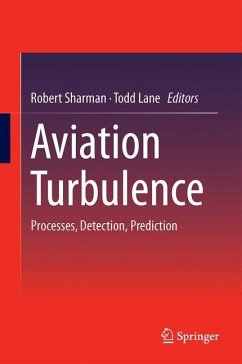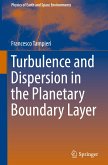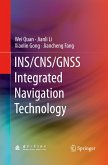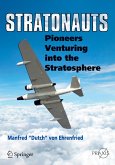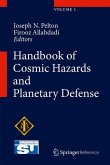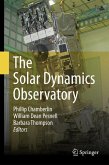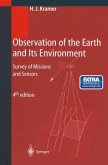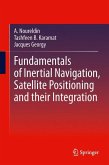Aviation Turbulence
Processes, Detection, Prediction
Herausgegeben:Sharman, Robert; Lane, Todd
Aviation Turbulence
Processes, Detection, Prediction
Herausgegeben:Sharman, Robert; Lane, Todd
- Gebundenes Buch
- Merkliste
- Auf die Merkliste
- Bewerten Bewerten
- Teilen
- Produkt teilen
- Produkterinnerung
- Produkterinnerung
Anyone who has experienced turbulence in flight knows that it is usually not pleasant, and may wonder why this is so difficult to avoid. The book includes papers by various aviation turbulence researchers and provides background into the nature and causes of atmospheric turbulence that affect aircraft motion, and contains surveys of the latest techniques for remote and in situ sensing and forecasting of the turbulence phenomenon. It provides updates on the state-of-the-art research since earlier studies in the 1960s on clear-air turbulence, explains recent new understanding into turbulence…mehr
Andere Kunden interessierten sich auch für
![Turbulence and Dispersion in the Planetary Boundary Layer Turbulence and Dispersion in the Planetary Boundary Layer]() Francesco TampieriTurbulence and Dispersion in the Planetary Boundary Layer93,99 €
Francesco TampieriTurbulence and Dispersion in the Planetary Boundary Layer93,99 €![INS/CNS/GNSS Integrated Navigation Technology INS/CNS/GNSS Integrated Navigation Technology]() Wei QuanINS/CNS/GNSS Integrated Navigation Technology77,99 €
Wei QuanINS/CNS/GNSS Integrated Navigation Technology77,99 €![Stratonauts Stratonauts]() Manfred 'Dutch' Von EhrenfriedStratonauts30,99 €
Manfred 'Dutch' Von EhrenfriedStratonauts30,99 €![Handbook of Cosmic Hazards and Planetary Defense Handbook of Cosmic Hazards and Planetary Defense]() Handbook of Cosmic Hazards and Planetary Defense565,99 €
Handbook of Cosmic Hazards and Planetary Defense565,99 €![The Solar Dynamics Observatory The Solar Dynamics Observatory]() The Solar Dynamics Observatory115,99 €
The Solar Dynamics Observatory115,99 €![Observation of the Earth and Its Environment Observation of the Earth and Its Environment]() Herbert J. KramerObservation of the Earth and Its Environment130,99 €
Herbert J. KramerObservation of the Earth and Its Environment130,99 €![Fundamentals of Inertial Navigation, Satellite-based Positioning and their Integration Fundamentals of Inertial Navigation, Satellite-based Positioning and their Integration]() Aboelmagd NoureldinFundamentals of Inertial Navigation, Satellite-based Positioning and their Integration89,99 €
Aboelmagd NoureldinFundamentals of Inertial Navigation, Satellite-based Positioning and their Integration89,99 €-
-
-
Anyone who has experienced turbulence in flight knows that it is usually not pleasant, and may wonder why this is so difficult to avoid. The book includes papers by various aviation turbulence researchers and provides background into the nature and causes of atmospheric turbulence that affect aircraft motion, and contains surveys of the latest techniques for remote and in situ sensing and forecasting of the turbulence phenomenon. It provides updates on the state-of-the-art research since earlier studies in the 1960s on clear-air turbulence, explains recent new understanding into turbulence generation by thunderstorms, and summarizes future challenges in turbulence prediction and avoidance.
Produktdetails
- Produktdetails
- Verlag: Springer / Springer International Publishing / Springer, Berlin
- Artikelnr. des Verlages: 978-3-319-23629-2
- 1st ed. 2016
- Seitenzahl: 540
- Erscheinungstermin: 6. Juli 2016
- Englisch
- Abmessung: 241mm x 160mm x 35mm
- Gewicht: 950g
- ISBN-13: 9783319236292
- ISBN-10: 3319236296
- Artikelnr.: 43362622
- Herstellerkennzeichnung Die Herstellerinformationen sind derzeit nicht verfügbar.
- Verlag: Springer / Springer International Publishing / Springer, Berlin
- Artikelnr. des Verlages: 978-3-319-23629-2
- 1st ed. 2016
- Seitenzahl: 540
- Erscheinungstermin: 6. Juli 2016
- Englisch
- Abmessung: 241mm x 160mm x 35mm
- Gewicht: 950g
- ISBN-13: 9783319236292
- ISBN-10: 3319236296
- Artikelnr.: 43362622
- Herstellerkennzeichnung Die Herstellerinformationen sind derzeit nicht verfügbar.
Dr. Robert Sharman is a project scientist at the Research Applications Laboratory, National Center for Atmospheric Research (NCAR) in Boulder, CO, U.S.A. Over the last 20 years he has been deeply involved in aviation turbulence research programs there, and oversees development of automated turbulence prediction systems and research into free atmosphere turbulence characterization using high resolution fluid dynamical numerical simulations to better define the turbulence structures associated with severe turbulence encounters by aircraft. Dr. Sharman is author or co-author of over 60 scientific articles in professional journals, primarily on the subjects of aviation turbulence prediction, turbulence characterization, topographically-induced, convectively-induced and shear-induced gravity waves and turbulence. He is a recipient of the SCIENTFIC AMERICAN Top 50 Scientists Award for 2003. Dr. Todd Lane is currently an Associate Professor and Reader in the School of Earth Sciences, The University of Melbourne, Australia. He obtained his PhD from Monash University, Australia in 2000 and between 2000-2005 he was a postdoctoral fellow and research scientist at National Center for Atmospheric Research in Boulder, Colorado USA. Over his career his research has focused on many aspects of meteorology, including thunderstorms, atmospheric gravity waves, topographic flows, and turbulence. Over the last 15 years he has applied state-of-the-art computer models to problems in aviation turbulence, with particular emphasis on the links between thunderstorms, waves and clear-air turbulence. Dr. Lane is author or co-author of over 50 scientific articles in peer-reviewed journals. He was 2014-2015 President of the Australian Meteorological and Oceanographic Society, and is currently a Chief Investigator of the Australian Research Council's Centre of Excellence for Climate System Science. He has received awards from the Australian Meteorological and Oceanographic Society, the American Meteorological Society, the Australian Academy of Science, and NASA.
Part I Background.- Nature of aviation turbulence.- A History of Weather Reporting from Aircraft and Turbulence Forecasting for Commercial Aviation.- Instabilities Conducive to Aviation Turbulence.- Turbulence events interpreted by vortex rolls.- Part II Turbulence Detection Methods and Applications.- Airborne in situ measurements of turbulence.- Doppler radar measurements of turbulence.- Remote Turbulence Detection using Ground-Based Doppler Weather Radar.- Relations between lightning and convective turbulence.- LIDAR-based turbulence intensity for aviation applications.- Part III Nowcasting, forecasting, and verification.- A Summary of Turbulence Forecasting Techniques Used by the National Weather Service.- An Airline Perspective: Current and Future Vision for Turbulence Forecasting and Reporting.- Automated Turbulence Forecasting Strategies.- Aviation turbulence forecast verification.- Aviation turbulence ensemble techniques.- Part IV Observational and modeling studies.- Multi-scale observational and numerical modeling studies of the turbulence environment.- Processes underlying near-cloud turbulence.- Modeling Studies of Turbulence Mechanisms Associated with Mesoscale Convective Systems.- Numerical Modeling and Predictability of Mountain Wave-Induced Turbulence and Rotors.- Gravity waves generated by jets and fronts and their relevance for clear-air turbulence.- Turbulence and waves in the upper troposphere and lower stratosphere.- Similarity of stably geophysical stratified flows.- Part V Future developments.- Airborne remote detection of turbulence with forward-looking LIDAR.- Clear-air turbulence in a changing climate.- Application of Aviation Turbulence Information to Air-Traffic Management (ATM).- Research needs.
Part I Background.- Nature of aviation turbulence.- A History of Weather Reporting from Aircraft and Turbulence Forecasting for Commercial Aviation.- Instabilities Conducive to Aviation Turbulence.- Turbulence events interpreted by vortex rolls.- Part II Turbulence Detection Methods and Applications.- Airborne in situ measurements of turbulence.- Doppler radar measurements of turbulence.- Remote Turbulence Detection using Ground-Based Doppler Weather Radar.- Relations between lightning and convective turbulence.- LIDAR-based turbulence intensity for aviation applications.- Part III Nowcasting, forecasting, and verification.- A Summary of Turbulence Forecasting Techniques Used by the National Weather Service.- An Airline Perspective: Current and Future Vision for Turbulence Forecasting and Reporting.- Automated Turbulence Forecasting Strategies.- Aviation turbulence forecast verification.- Aviation turbulence ensemble techniques.- Part IV Observational and modeling studies.- Multi-scale observational and numerical modeling studies of the turbulence environment.- Processes underlying near-cloud turbulence.- Modeling Studies of Turbulence Mechanisms Associated with Mesoscale Convective Systems.- Numerical Modeling and Predictability of Mountain Wave-Induced Turbulence and Rotors.- Gravity waves generated by jets and fronts and their relevance for clear-air turbulence.- Turbulence and waves in the upper troposphere and lower stratosphere.- Similarity of stably geophysical stratified flows.- Part V Future developments.- Airborne remote detection of turbulence with forward-looking LIDAR.- Clear-air turbulence in a changing climate.- Application of Aviation Turbulence Information to Air-Traffic Management (ATM).- Research needs.

